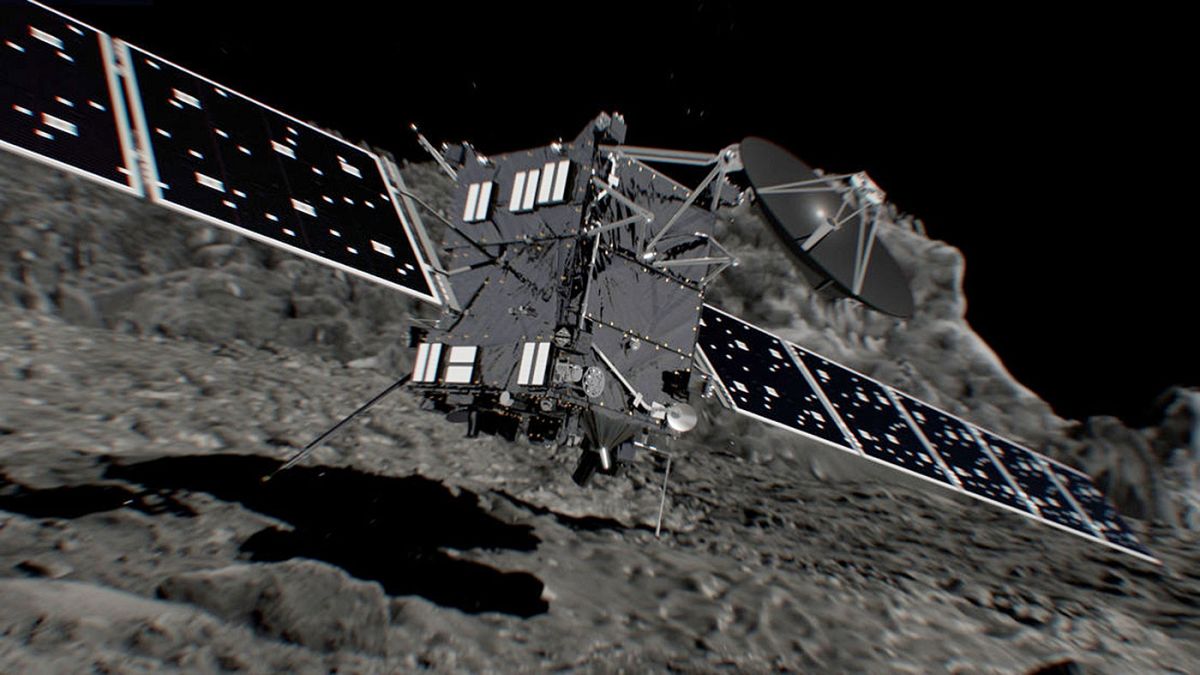Scientists at the ESA control centre in Germany clapped and hugged after screens showed the loss of signal after the final, historic touchdown.
The Final Touchdown
The European Space Agency says its Rosetta spacecraft has finally crash-landed on its comet.
Scientists at the control centre in Darmstadt clapped and hugged after screens showed the loss of signal when Rosetta touched down on the space rock, known as “67P/Churyumov-Gerasimenko”.
Leaving the empire of the Sun
The ESA is ending the mission because 67P is racing toward the outer solar system, out of range for the solar-powered spacecraft.
Rosetta has also been subjected to the harsh radiation and extreme temperatures of space since launching in March 2004 and is unlikely to last too much longer.
A not-so-brief encounter
Rosetta has spent an historic 12 years chasing the comet across more than six billion kilometres of space.
The spacecraft has collected a treasure trove of information on comets that will keep scientists busy for the next decade.
The mission managed several historic firsts, such as getting a spacecraft into orbit around a comet and the unprecedented landing of a probe on its surface.
A handful of previous spacecraft had snapped pictures and collected data, but only as they flew past their targets.
Philae
The installation of the Philae probe on the comet’s surface did not go as planned, however.
The 100 kg instrument bounced several times on landing before getting stuck against a cliff wall.
This left it unable to perform any more experiments beyond its first three days on the comet, which is when its solar-powered batteries ran out.
Rosetta’s cameras finally located the missing Philae just a few weeks ago.
Big Data
The data collected by Rosetta and Philae is already helping scientists better understand how the Earth and other planets formed.
For example, scientists now believe that asteroids, not comets, were primarily responsible for delivering water to Earth and other planets in the inner solar system.
This could have set the stage for life systems to develop.
Before reaching the surface and shutting down, Rosetta’s instruments and camera relayed back data and images.
This has given scientists insight into the structure of the comet.
It is hoped the data will reveal:
- crucial information on the formation of the comet’s walls
- information on 100-metre wide pits, thought to release gas and dust when warmed by the sun
The Last Goodbye – in tweets
Landing site targetted for
ESA_Rosetta</a> <a href="https://twitter.com/hashtag/cometlanding?src=hash">#cometlanding</a> <a href="https://t.co/LHGuw2hZF8">https://t.co/LHGuw2hZF8</a> <a href="https://t.co/sQLdolVIbc">pic.twitter.com/sQLdolVIbc</a></p>— ESA (esa) September 30, 2016
LOSS OF SIGNAL #LOS European Space Agency confirms end of contact w/
ESA_Rosetta</a>. Operations complete at 720mn km from Earth <a href="https://twitter.com/hashtag/CometLanding?src=hash">#CometLanding</a> <a href="https://t.co/ehzQ5gMf1W">pic.twitter.com/ehzQ5gMf1W</a></p>— ESA Operations (esaoperations) September 30, 2016
Before & after:
ESA_Rosetta</a> signal peak just prior to <a href="https://twitter.com/hashtag/cometlanding?src=hash">#cometlanding</a> - then it was gone <a href="https://t.co/kSnvApCaCi">pic.twitter.com/kSnvApCaCi</a></p>— ESA Operations (esaoperations) September 30, 2016
Mission complete:
ESA_Rosetta</a>'s journey ends in daring descent to the comet <a href="https://twitter.com/hashtag/CometLanding?src=hash">#CometLanding</a> <a href="https://t.co/vRxSZpir4K">https://t.co/vRxSZpir4K</a> <a href="https://t.co/1yG73DHY0W">pic.twitter.com/1yG73DHY0W</a></p>— ESA (esa) September 30, 2016
Goodbye
ESA_Rosetta</a> what an adventure! We'll be busy with your <a href="https://twitter.com/hashtag/comet?src=hash">#comet</a> science for a long time to come <a href="https://twitter.com/hashtag/CometLanding?src=hash">#CometLanding</a> <a href="https://t.co/hk0SEnRhop">https://t.co/hk0SEnRhop</a></p>— ESA (esa) September 30, 2016
Thank you
ESA_Rosetta</a>, well done! <a href="https://twitter.com/hashtag/CometLanding?src=hash">#CometLanding</a></p>— Jan Woerner (janwoerner) September 30, 2016
Good night – and good luck
Daniel Brown, an astronomy expert at Nottingham Trent University, says the images sent back from the Rosetta mission are “as powerful as Neil Armstrong’s first steps on the Moon.”
“We have just scratched the surface of the science. We are ending the mission, but the science will continue for many years,” – project scientist Matt Taylor.
